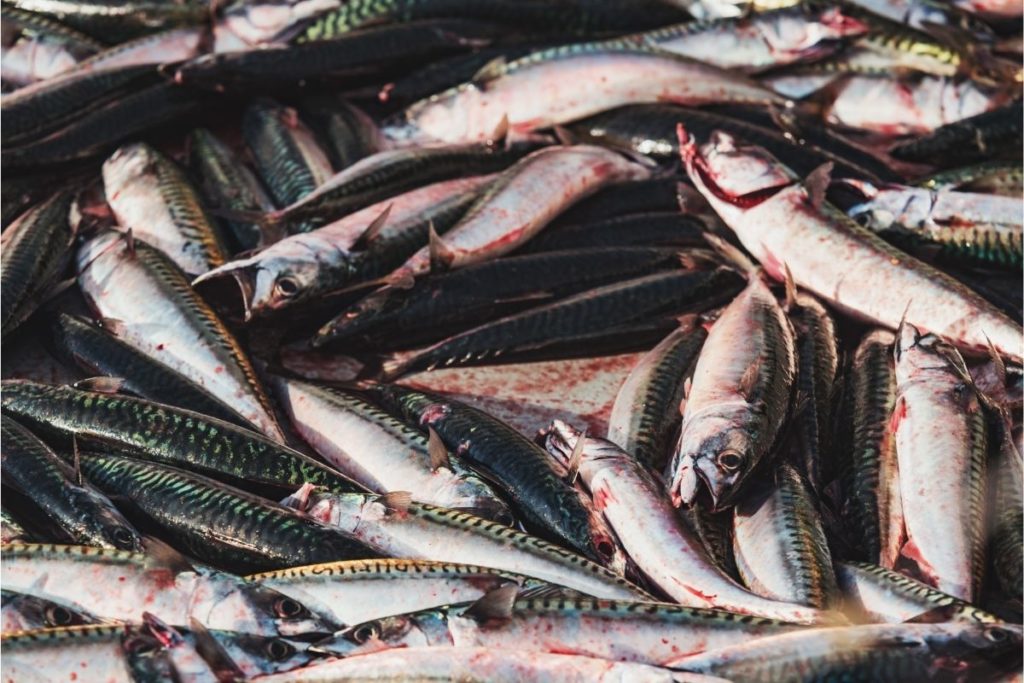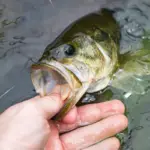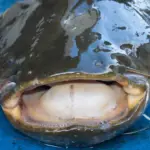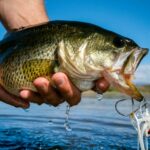We just love fish here at Irvine Lake, and one of our favorites to eat is Spanish Mackerel. This has a delicious seafood flavor that really goes well with a lot of different accompaniments, and overall makes a very popular dish.

Unfortunately, it is not often on the menu at seafood or other restaurants, so you will probably have to catch some yourself if you want to enjoy the flavor.
The fish has a very distinctive look that is different from other species of mackerel, which means it’s easy to spot at a fishmonger or catch a glimpse of in the water.
The back is green in color, with silver sides and a pattern of small scales. Spanish Mackerel grow up to 36 inches long and can weigh as much as 14 pounds, although they come in a variety of sizes.
In this article, we will take you through everything you need to know about Spanish Mackerel, from catching them to preparing them for eating.
This way, you can experience a whole new taste that you may not have tried before, as well as introduce this special fish to your friends and family.
Catching Spanish Mackerel
The main catching process is similar to that for most fish. There are, however, some additional things that you will need to take into account before you start.
You may have varying levels of success if you just try your normal methods, but it is better to follow specific instructions that have been tailored for Spanish Mackerel and their habits.
Bait Fish
You need to choose your bait fish carefully. The ones that are best for catching Spanish Mackerel are small bait fish such as sardines and threadfin herring.
These are silvery in color and rich in scales, so they will be attractive to the mackerel in both appearance and smell.
You can also use live shrimp as bait fish – it is important that they are alive when you use them, as otherwise they will not be effective.
Where to Find
Spanish Mackerel often swim in inshore waters and gulf shores. They are particularly abundant around the gulf of mexico, because that is where they swim to in large droves in the springtime.
Therefore, you should be able to find plenty of them around the gulf coast around March/April, and it is the best place to fish for them in the Atlantic Ocean.
In the summer months, Spanish Mackerel from Florida migrate to Chesapeake Bay and other mid-atlantic regions. They are there by around May/June, then return to Florida when the fall comes.
This is because they need to be in warm water to thrive, so it makes sense for them to move around based on seasonal temperatures.
Catching Tips
Certain clues can give you an idea of where these fish are to be found. For example, birds circling above the surface of the water may indicate the presence of Spanish Mackerel – while the birds grab the small fish that swim close to the surface, the mackerel often eat them from below.
This usually happens in the morning, when the birds generally feed – it is worth going out early in your boat to catch them in the act.
Trolling is a very popular way of catching these fish. This is where you trail a small metallic spoon on a 30 pound test leader behind a diving planer.
The best speed to troll for most efficiency is 5-7 mph, although you can boost this by a couple miles an hour if there are other fish that you don’t want to catch among the spanish mackerel that swim there.
You can also cast to them as an alternative method. You can use medium rods while casting sinking plugs and small spoons.
This works particularly well when you have caught sight of a whole school of the mackerel, and they are following bait that is on the water’s surface. Just make sure that you don’t let the bait fish come to a stop while you’re casting, because they are only interested in quick-moving bait.
Potential Issues You May Encounter
Catching Spanish Mackerel can be difficult if you don’t know exactly what you’re looking for, as they can be mistaken for other fish that you might not want to catch.
For example, Spanish Mackerel look a lot like King Mackerel, especially when you compare the adult of the former species with the juvenile of the latter.
Therefore, you might think that you’ve caught a load of Spanish Mackerel, when you’ve actually caught King Mackerel. While they are both delicious to eat, catching the wrong type could see you on the wrong side of the law if you’re not careful.
There are different regulations in place that govern the fishing of these species. The exact daily bag limit will vary from state to state, but for Spanish Mackerel it tends to be around 15 per person per day.

In comparison, the limit for King Mackerel will be between 1 and 3 per person per day only. This means that it can be very bad if you end up with more of these than you were expecting.
When you next go on a fishing trip, whether using your own boat or a fishing charter, keep these figures in mind. It is also a good idea to read up on the specific regulations in your own state, so you can be sure that you’re not overloading your fish box with the wrong fish.
The numbers we have cited represent the average recreational bag limit, while commercial bag limits will probably be higher.
This is because the governing bodies want to keep track of the recreational harvest of these species as much as possible, so that it doesn’t impact on either the sale of fish or the populations of certain species.
Cleaning Spanish Mackerel
Once you have caught your Spanish Mackerel, you will need to clean it properly before you can eat it, because otherwise you won’t get the best results in the end.
Not many people realize it, but cleaning your fish is actually one of the most important factors in how it tastes, so we’ll show you how to make the most of it here.
Luckily, Spanish Mackerel is a relatively easy fish to clean, and you don’t need to utilize any particular techniques or equipment in order to be successful in this area.
In fact, if you are skilful enough, you can even clean the entire thing in under 2 minutes. However, this doesn’t mean that you should rush the process, and taking care to be thorough is the most important thing.
There are still aspects of the cleaning that can be difficult, because they are quite delicate in certain places.
Unlike some other fish with bigger scales, you don’t need to remove the scales before cleaning a Spanish Mackerel and fileting it.
To start with, make sure you have a fileting knife to hand, or at least a sharp utility knife. This is an essential tool that will help you to make clear cuts, rather than having to hack away at the flesh and risk damaging it.
The Cleaning Process – Step By Step
1. Lay the mackerel flat on a chopping board and cut off its head. You can leave the head on instead if you want, but you’ll still need to cut the throat all the way across, from one gill to the other.
2. Turn the fish over so that you can locate its sphincter. It is easier if you hold it by its back, as the tiny opening will be more visible this way. Lightly pierce the skin in that spot with the tip of your knife, but try not to go any deeper than that.
3. With the knife still just under the skin, make a cut along the whole length of the fish, to meet the throat slit (or the place where the head would join onto the neck).
4. Scoop out the organs inside the body, using your finger or a tool set if you prefer. Many people like to wear disposable gloves for this step, so that the gooey parts don’t actually come into contact with their skin and make them smell strongly of fish.
5. Rinse the whole thing thoroughly, paying particular attention to the belly cavity you’ve just excavated. You should be left with a perfectly clean fish that is ready to filet.
Cleaning and Fileting – Step By Step
If you’d rather, you can actually clean and filet the fish in the same process with just two knife cuts. This means you don’t have to do both separately, and it might save you time in the long run.
This is usually performed by skilled chefs who really know their way around their fish, but anyone can attempt it and even have a lot of success.
It also means you will probably end up with less mess, as long as you manage to follow the instructions accurately. Here’s how to do it:
1. Using the tips of your fingers, feel around the mackerel to find the start of its belly cavity. You should be able to locate the point at which the firm meat gives way to softer flesh.
2. Holding the fish’s head only, cut down deeply with your knife from the neck all the way to the spine. In one stroke, continue pulling the blade towards the tail. Make sure that you angle the knife so that you avoid hitting the belly cavity and accidentally cutting into it.
3. Turn the fish over so that you can do the same thing on the other side. You should be left with two separate filets, as well as the cavity holding the organs – you can discard this in an appropriate way.
This is a good skill to learn if you enjoy fish, because it means that you will be able to oversee the entire preparation process, without the need for others such as fishmongers to do it for you.
Whether you are catching the fish yourself straight from the Atlantic Ocean or buying whole fish from a market, it is easier to tell if they are fresh than if you simply bought pre-filleted ones. Plus, it gives many cooks a sense of achievement and authenticity to accomplish such a task.
Cooking Spanish Mackerel
Now all that’s left is to cook the mackerel; after all, we don’t recommend you try to eat it raw! There are many ways you can cook Spanish Mackerel, so it’s a good idea to experiment and find out which method you like best.
You can also draw inspiration from famous chefs who know what they’re talking about in this area, so that you don’t end up detracting from the awesome flavor.
Spanish Mackerel Recipes
The chef Guy Fieri has a cooking show on the Food Network called Diners, Drive-Ins and Dives, where he travels around the country trying our food from various establishments.
Guy Fieri judged Ted Peters’ Famous Smoked Fish to include some of the best Spanish Mackerel he had tasted. This recipe is inspired by the very fish served there, and adapts the original method for less-experienced cooks. You will be able to make a dish that would impress Guy Fieri himself.
Alternatively, Sunny Anderson shares how she prepares the fish with her Salt-Grilled Spanish Mackerel recipe. This uses the unique taste of daikon (Japanese or Chinese radish) to bring out the exquisite flavors of the fish.
The recipe is very Japanese-inspired, as sake is also an intrinsic part of it and helps keep the whole thing succulent and moist.
Serving Spanish Mackerel
If you’re not following a recipe that tells you the whole process and everything to cook with it, you might be wondering what the best way to serve your Spanish Mackerel is.
You’ll be pleased to know that it goes well with a whole range of foods, but is particularly good when eaten with seasonal vegetables and potatoes.
Portion Size
It is sometimes tricky to work out how much fish per person you should be serving, since an individual Spanish Mackerel is rather large; it wouldn’t make sense to dish out an entire mackerel for each guest.
Luckily, there are some good rules of thumb you can use to help you stick to reasonable size limits, depending on how you are eating it.
If you’re having the fish whole and without any kind of preparation, aim to eat around 3/4-1 pound each. With cleaned fish that has been dressed, a sufficient portion is more like 1/2 pound.
With mackerel steaks or filets, you should be having 1/4-1/3 pounds of fish per person. As you can see, the more that is done with your fish beforehand, the smaller the ideal portion size.
This means you will still be eating roughly the same amount of actual fish, but there is less other stuff in the way the more you process it. A filet is certainly the most efficient way to eat Spanish Mackerel to reap all the nutritional benefits it has.
Final Thoughts
Spanish Mackerel is a delicious fish for any meal, and is versatile enough that you can serve it well with whatever you like. The various methods of cooking it include frying, grilling, roasting and broiling, so it’s really up to you which one you would prefer.
Roasting is probably the easiest, but why not experiment with different ways to really experience the range of tastes you can create?
In terms of catching the fish, you will need to familiarize yourself with the regulations wherever you are, as you don’t want to be caught out by bag size limits of how many you can catch per person per day.
Coastal areas of the Atlantic Ocean are abundant with Spanish Mackerel, such as the Gulf of Mexico, other gulf shores, and North Carolina.
You will have more success in certain places depending on the weather, so it is good to follow their seasonal migration patterns if you can.
Another important factor in enjoying your Spanish Mackerel is how clean it is before you tuck in. Nobody wants to eat fish that is loaded with grit and still has organ remnants hanging onto the flesh, so be careful not to skip this stage.
It is relatively easy to do this with a Spanish Mackerel, since they are large enough not to be fiddly, but also not too big that you can’t get a suitable grip on them.
This is one of the reasons why we especially love this kind of fish – anyone who wants to can learn to catch, clean and cook their Spanish Mackerel and produce wonderful dishes.
- Do You Need An Indicator For Nymph Fishing? - November 16, 2023
- Fishing Safety Tips For Families - September 25, 2023
- What Is The Best Time To Night Fish At A Lake? - September 18, 2023





![Is Carp Good To Eat (Or Bad)? [Taste, Safe & Prepare] Is Carp Good To Eat](https://irvinelake.net/wp-content/uploads/2022/02/Is-Carp-Good-To-Eat-150x150.png)



